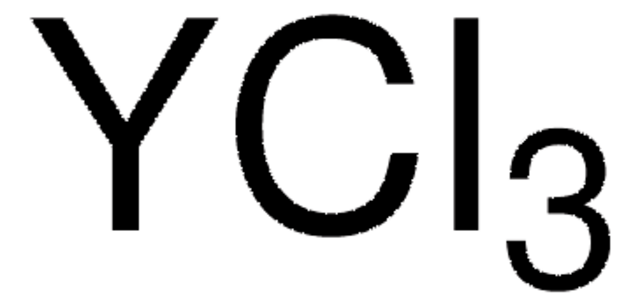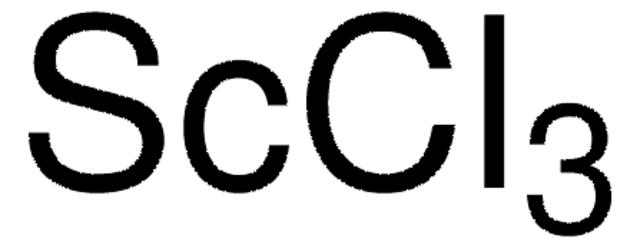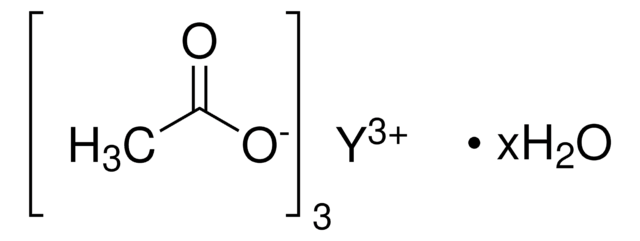Kluczowe dokumenty
464317
Yttrium(III) chloride hexahydrate
99.99% trace metals basis
Synonim(y):
Yttrium trichloride hexahydrate
About This Item
Polecane produkty
klasa czystości
for analytical purposes
Poziom jakości
Próba
99.99% trace metals basis
Formularz
powder
zanieczyszczenia
≤150.0 ppm Trace Rare Earth Analysis
mp
100 °C (dec.) (lit.)
gęstość
2.18 g/mL at 25 °C (lit.)
ciąg SMILES
[H]O[H].[H]O[H].[H]O[H].[H]O[H].[H]O[H].[H]O[H].Cl[Y](Cl)Cl
InChI
1S/3ClH.6H2O.Y/h3*1H;6*1H2;/q;;;;;;;;;+3/p-3
Klucz InChI
IINACGXCEZNYTF-UHFFFAOYSA-K
Szukasz podobnych produktów? Odwiedź Przewodnik dotyczący porównywania produktów
Powiązane kategorie
Zastosowanie
- As a precursor to synthesize Y2O3–MgO nanocomposites via sol-gel processing.
- To prepare finely dispersed yttrium-aluminum garnet (YAG) powder for laser ceramics.
- As an additive to enhance the catalytic performance of activated carbon-supported Au catalyst (Au/AC).
Hasło ostrzegawcze
Danger
Zwroty wskazujące rodzaj zagrożenia
Zwroty wskazujące środki ostrożności
Klasyfikacja zagrożeń
Aquatic Acute 1 - Aquatic Chronic 1 - Eye Dam. 1 - Skin Sens. 1B
Kod klasy składowania
11 - Combustible Solids
Klasa zagrożenia wodnego (WGK)
WGK 3
Temperatura zapłonu (°F)
Not applicable
Temperatura zapłonu (°C)
Not applicable
Środki ochrony indywidualnej
dust mask type N95 (US), Eyeshields, Gloves
Wybierz jedną z najnowszych wersji:
Masz już ten produkt?
Dokumenty związane z niedawno zakupionymi produktami zostały zamieszczone w Bibliotece dokumentów.
Klienci oglądali również te produkty
Produkty
The rare earth elements impact nearly everyone in the world. All of the people living in advanced technological countries and almost all those living in third world countries utilize the rare earths in their everyday living—the car that one drives (gasoline is refined from oil using rare earth catalysts and catalytic converters reduce the polluting emissions from the automotive exhaust), watching the news on TV (the red and green colors in TV screens), the telephones and computers we use to communicate (the permanent magnets in speakers and disc drives), just to name a few examples.
Nasz zespół naukowców ma doświadczenie we wszystkich obszarach badań, w tym w naukach przyrodniczych, materiałoznawstwie, syntezie chemicznej, chromatografii, analityce i wielu innych dziedzinach.
Skontaktuj się z zespołem ds. pomocy technicznej












